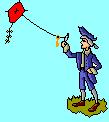|
Standard 4.3 -
Electricity
Keep reading to find out what you will
be expected to know! |
The student will investigate and understand the characteristics of
electricity. Key concepts include
a) conductors and insulators;
b) basic circuits (open/closed, parallel/series);
c) static electricity;
d) the ability of electrical energy to be transformed into heat, light, and
mechanical energy;
e) simple electromagnets and magnetism: and
f) historical contributions in understanding electricity. |
|
The concepts developed in this standard include the
following: |

Electric Current |
A continuous flow of negative charges (electrons) creates an
electric
current. The pathway taken by a electric current is a
circuit. (Students
should be able to use the dry cell symbols (-) and (+).) |
| Open
and Closes Circuits |
Closed
circuits allow the movement of electrical energy.
Open circuits prevent the
movement of electrical energy.
Battery & Light bulb animation (Shockwave)
Directions - close and open the circuit by clicking the switch |
Conductors and Insulators
 |
∑ Electrical energy moves through materials that are
conductors
(metals).
Insulators (rubber, plastic, wood) do not conduct electricity well. |
Resistance
Read more about resistance |
∑ Among conducting materials, energy passes more or less easily because of
the materialís resistance. |
In a
series circuit
there is only one
pathway for the current
 |
|
A series circuit -
one pathway |
|
|
In a
parallel circuit there are two or more pathways for it.
|
 |
|
A parallel circuit
- more than one pathway |
|
|

Static
Electricity |
∑ Rubbing certain materials together creates
static electricity.
∑ Lightning is the discharge of static electricity in the atmosphere. |

Energy
Transformations
|
∑ Electrical energy can be
transformed into heat, light, or mechanical
energy. |
 Magnets Magnets |
∑ Certain
iron-bearing metals attract other such metals (also nickel and
cobalt). (Students should be able to compare and contrast a
permanent magnet made for iron bearing metals and an
electromagnet which can be turned on and off) |
 Lines
of Force, Magnetic fields Lines
of Force, Magnetic fields
|
Lines of force extend from the poles of a magnet in an arched pattern
defining the area over which magnetic force is exerted. (Students should be
able to create a diagram of a magnetic field using a magnet.)
An electric current creates a magnetic field, and a
moving magnetic field
creates an electric current. (Students should be able to explain how electricity is generated by a moving magnetic field.) |

Simple
Electromagnets |
A current flowing through a wire creates a magnetic field. Wrapping a wire
around certain iron-bearing metals (iron nail) and creating a closed circuit
is an example of a simple electromagnet.
(Students should be able to design and perform an investigation
to determine the strength of an
electromagnet. (The manipulated variable could be the
number of coils of wire and the responding variable could be
the number of paperclips the magnet can attract.)) |
|
Historical Contributions
Electricity timeline |
∑
Benjamin Franklin, Michael Faraday, and
Thomas Edison made important
discoveries about electricity. |
 Benjamin
Franklin Benjamin
Franklin
Electricity in Lightning
In 1752, Benjamin Franklin flew a kite with a metal tip into a
thunderstorm to prove that lightning is a form of electricity. He was
very lucky he wasn't killed! |
 Michael
Faraday Michael
Faraday
Electro-
magnetism
In 1831, Michael Faraday demonstrated electromagnetic induction by
passing a magnet through a coil of wire.
|
 Thomas
Edison Thomas
Edison
Electric Lighting
In the 1870's, Edison built an electric generator and soon after
demonstrated electric lighting for the first time in America. |
|











 Magnets
Magnets Lines
of Force, Magnetic fields
Lines
of Force, Magnetic fields
 Michael
Faraday
Michael
Faraday  Thomas
Edison
Thomas
Edison